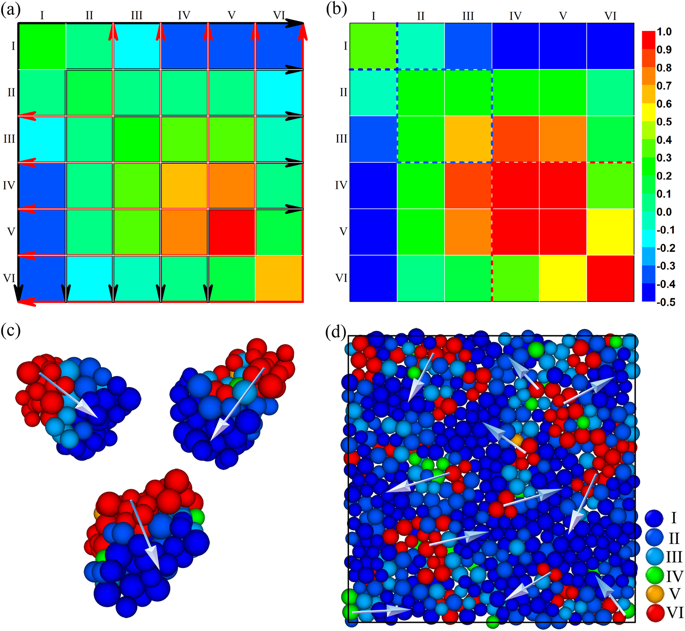npj Computational Materials ( IF 9.7 ) Pub Date : 2018-07-30 , DOI: 10.1038/s41524-018-0097-4 Binbin Wang , Liangshun Luo , Enyu Guo , Yanqing Su , Mingyue Wang , Robert O. Ritchie , Fuyu Dong , Liang Wang , Jingjie Guo , Hengzhi Fu

|
The hidden order of atomic packing in amorphous structures and how this may provide the origin of plastic events have long been a goal in the understanding of plastic deformation in metallic glasses. To pursue this issue, we employ here molecular dynamic simulations to create three-dimensional models for a few metallic glasses where, based on the geometrical frustration of the coordination polyhedra, we classify the atoms in the amorphous structure into six distinct species, where “gradient atomic packing structure” exists. The local structure in the amorphous state can display a gradual transition from loose stacking to dense stacking of atoms, followed by a gradient evolution of atomic performance. As such, the amorphous alloy specifically comprises three discernible regions: solid-like, transition, and liquid-like regions, each one possessing different types of atoms. We also demonstrate that the liquid-like atoms correlate most strongly with fertile sites for shear transformation, the transition atoms take second place, whereas the solid-like atoms contribute the least because of their lowest correlation level with the liquid-like atoms. Unlike the “geometrically unfavored motifs” model which fails to consider the role of medium-range order, our model gives a definite structure for the so-called “soft spots”, that is, a combination of liquid-like atoms and their neighbors, in favor of quantifying and comparing their number between different metallic glasses, which can provide a rational explanation for the unique mechanical behavior of metallic glasses.
中文翻译:

围绕金属玻璃中的软点的纳米级梯度原子堆积结构
长期以来,了解非晶态结构中原子堆积的隐藏顺序及其如何提供塑性事件的起源一直是理解金属玻璃塑性变形的目标。为了解决这个问题,我们在这里使用分子动力学模拟为一些金属玻璃创建三维模型,其中基于配位多面体的几何受挫,我们将非晶结构中的原子分为六个不同的物种,其中“梯度”存在原子堆积结构”。非晶态的局部结构可以显示出从松散堆积到密集堆积的逐渐过渡,随后是原子性能的梯度演化。因此,非晶态合金特别包含三个可辨别的区域:固体,过渡和液体区域,每个拥有不同类型的原子。我们还证明,液态原子与剪切转换的可育位点相关性最强,跃迁原子排在第二位,而固态原子的贡献最小,因为它们与液态原子的相关性最低。与“几何上不利的基元”模型没有考虑中间范围的作用不同,我们的模型为所谓的“软点”提供了确定的结构,即类似液体的原子及其邻居的组合,有助于量化和比较不同金属玻璃之间的数量,这可以为金属玻璃的独特机械性能提供合理的解释。我们还证明,液态原子与剪切转换的可育位点相关性最强,跃迁原子排在第二位,而固态原子的贡献最小,因为它们与液态原子的相关性最低。与“几何上不利的基元”模型没有考虑中间范围的作用不同,我们的模型为所谓的“软点”提供了确定的结构,即类似液体的原子及其邻居的组合,有助于量化和比较不同金属玻璃之间的数量,这可以为金属玻璃的独特机械性能提供合理的解释。我们还证明,液态原子与剪切转换的可育位点相关性最强,跃迁原子排在第二位,而固态原子的贡献最小,因为它们与液态原子的相关性最低。与“几何上不利的基元”模型没有考虑中间范围的作用不同,我们的模型为所谓的“软点”提供了确定的结构,即类似液体的原子及其邻居的组合,有助于量化和比较不同金属玻璃之间的数量,这可以为金属玻璃的独特机械性能提供合理的解释。固态原子的贡献最小,因为它们与液态原子的相关程度最低。与“几何上不利的基元”模型没有考虑中间范围的作用不同,我们的模型为所谓的“软点”提供了确定的结构,即类似液体的原子及其邻居的组合,有助于量化和比较不同金属玻璃之间的数量,这可以为金属玻璃的独特机械性能提供合理的解释。固态原子的贡献最小,因为它们与液态原子的相关程度最低。与“几何上不利的基元”模型没有考虑中间范围的作用不同,我们的模型为所谓的“软点”提供了确定的结构,即类似液体的原子及其邻居的组合,有助于量化和比较不同金属玻璃之间的数量,这可以为金属玻璃的独特机械性能提供合理的解释。


























 京公网安备 11010802027423号
京公网安备 11010802027423号